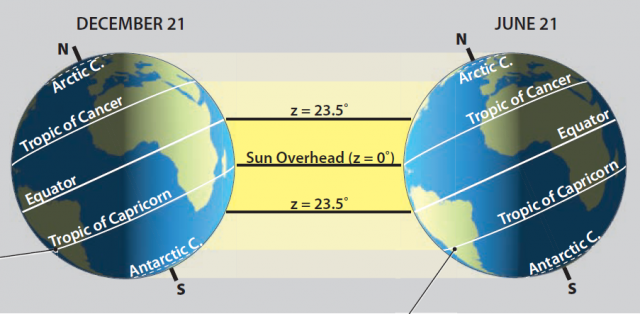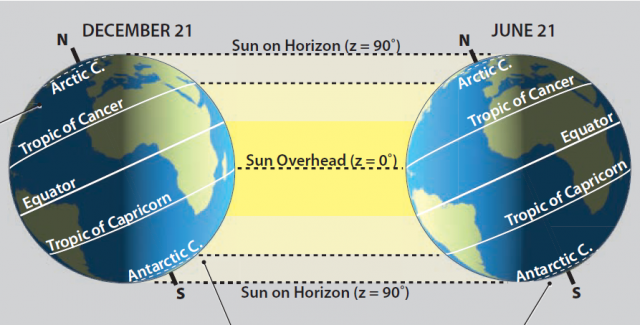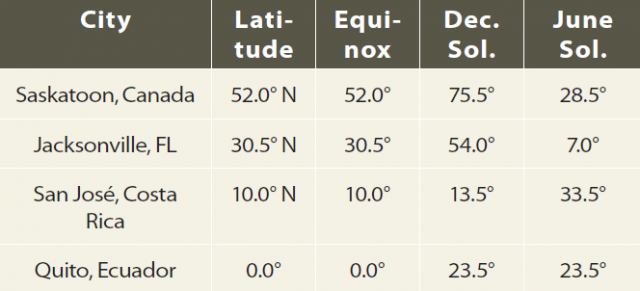Why Do We Have Seasons?
DURING THE YEAR MOST LOCATIONS progress through different seasons, from warmer summers to cooler winters and back again. The progression from season to season accompanies changes in the position of the Sun, such as from higher in the sky during the summer to lower in the sky during the winter. Except at the equator, the durations of daylight and darkness also vary, with longer days during the summer and longer nights during the winter. What causes most parts of Earth to have different seasons? Why do tropical areas not have summer and winter?
What Causes the Seasons?
The annual “march of the seasons” indicates variations in the amount of sunlight received at different latitudes during the course of a year. The main cause of these variations is that Earth's axis of rotation, about which our planet spins once during a 24-hour day, is tilted relative to the plane in which we orbit the Sun, the orbital plane.
- Earth's axis of rotation is tilted relative to our planet's orbital plane, as shown by the figure below, which is a sideways perspective of Earth's nearly circular orbit. The axis remains fixed in orientation with respect to the orbital plane and the stars throughout the year — the tilt does not change during a year. As Earth orbits the Sun, the Northern Hemisphere faces in the direction of the Sun during some times of the year, while the Southern Hemisphere faces the Sun at other times. Observe the relationship between the orientation of the rotation axis and the direction to the Sun.
- During December, the North Pole and Northern Hemisphere face away from the Sun. The Northern Hemisphere therefore receives less direct insolation and so experiences the cooler temperatures of winter. Rotation about the axis brings most parts of the hemisphere into the sunlight for part of the day.
- In contrast, the South Pole and Southern Hemisphere more directly face the Sun and receive more direct insolation. The Southern Hemisphere therefore has its summer (at the same time the Northern Hemisphere has its winter). The December Solstice (Winter Solstice in the Northern Hemisphere, Summer Solstice in the Southern Hemisphere) is the date when the North Pole (marking Earth's rotation axis) is pointed most away from the Sun.
- As Earth orbits around the Sun, the rotation axis no longer points directly away from the Sun. In March (and later again in September), Earth's axis is pointing sideways relative to the Sun — neither the North Pole nor the South Pole is inclined toward the Sun. In this position, neither hemisphere receives more insolation than the other, and so both experience the more moderate temperatures of spring and fall. The March Equinox and September Equinox are times when the axis is exactly sideways and the durations of daylight and darkness are equal (equinox is Latin for “equal night”).
- Between March and June, Earth's continued orbit causes the North Pole and Northern Hemisphere to increasingly face the Sun and to warm up as summer approaches. During this time, the South Pole and Southern Hemisphere begin to face away from the Sun, cooling down on the way to winter.
- In late June, the North Pole and Northern Hemisphere more directly face the Sun and so start to experience summer. The June Solstice (Summer Solstice in the Northern Hemisphere) marks the date when the North Pole's rotation axis is pointed most directly toward the Sun. At the same time, the South Pole and Southern Hemisphere face away from the Sun and start to experience winter.
- The seasons therefore are controlled by the relationship between the tilt of Earth's rotation axis and the orbit of Earth around the Sun. Each season is bounded by a solstice and an equinox, which in turn represent days of either a maximum or minimum amount of apparent tilt relative to the Sun.
- In thinking about the seasons, it is important to remember that Earth's orbit is nearly circular, as shown in this view looking straight down on Earth's orbital plane. In this figure, as in the one above, the sizes of the Earth and Sun are greatly exaggerated relative to the size of the orbit, and the Earth is shown much larger than it actually is relative to the Sun.
- The nearly circular geometry of Earth's orbit reinforces the fact that seasons are not caused in any way by differences in distance from the Sun. In fact, Earth is slightly closer to the Sun during the northern winter (perihelion) and slightly farther away during the northern summer (aphelion), opposite to what would be required to explain the seasons. 10. In each globe, Earth's rotation axis is represented by the small purple rod protruding from the North Pole (pointing toward the viewer and a little toward the left). Note that the axis points in the same direction throughout the year — it points toward Polaris, the North Star (not shown). Over thousands of years, the axis varies in orientation, not always pointing at Polaris. The amount of tilt varies by a degree either way (22.5° to 24.5°) over 40,000 years, but we are most interested here in the current tilt of 23.5°, an angle that will reappear throughout this book.
What Factors Determine the Temporal and Spatial Variations in Insolations?
Earth's rotational axis is tilted relative to the plane in which we orbit the Sun (the orbital plane). The tilt of the axis is currently 23.5° from vertical to the orbital plane, an angle that is reflected in important geographic features on our planet, including how we define the Tropic of Cancer, Tropic of Capricorn, Arctic Circle, and Antarctic Circle.
The Tropics
- These two globes show the Earth on the solstices — days when one of the poles is most exposed to the Sun and the other pole most faces away. During the December Solstice, the noon Sun is no longer directly overhead at the equator but instead is 23.5° to the south, directly over the Tropic of Capricorn. On this day, the equator has a zenith angle of 23.5°.
- During the December Solstice, the Southern Hemisphere receives the maximum amount of insolation it will receive all year, marking the start of the southern summer. Also on this day, the Northern Hemisphere receives the least amount of insolation for the year, marking the beginning of the northern winter.
- During the June Solstice, Earth is on the opposite side of the Sun, and the North Pole faces toward the Sun by its maximum amount. The overhead Sun, and the position of maximum insolation, have migrated to a latitude 23.5° north of the equator, the Tropic of Cancer. On the day of the June Solstice, the Northern Hemisphere receives the most insolation of the year, shifting into summer, while the Southern Hemisphere receives the least amount and moves into winter.
- The rest of the year, the overhead Sun migrates between the Tropics of Cancer and Capricorn, delivering relatively intense and constant insolation between these latitudes, causing a warm region called the tropics. In contrast, mid-latitude and polar regions receive a highly variable supply of energy and exhibit more variability during the year — that is, they exhibit more seasonality.

The Polar Circles
5. These two globes show the same two days as those above, the solstices. During the December Solstice, the northward limit of sunlight is the Arctic Circle, located at a latitude of 66.5° N, or 23.5° south of the North Pole. Along the Arctic Circle, the Sun will barely appear on the horizon at noon time and then disappear for a very long night. All places north of that latitude receive no insolation on this day—they have 24 hours of darkness.
6. Note that the entire Antarctic Circle, in the Southern Hemisphere, is illuminated, but with very oblique sunlight (high zenith angles). As the Earth completes its daily rotation, the South Pole and nearby areas remain in the sunlight all 24 hours — these places have 24 hours without darkness.

7. During the June Solstice, locations in the Southern Hemisphere now face away from the Sun. The southern limit of sunlight is the Antarctic Circle, at latitude 66.5° S. Here, the Sun will appear on the horizon for a brief moment at noon.
8. At this time, the area within the Arctic Circle (66.5° N) is fully illuminated. Note that the same angles keep reoccurring—23.5° and 66.5° (which is 90° minus 23.5°). These values, for the two tropics (Cancer and Capricorn) and for the two polar circles (Arctic and Antarctic), are the same as the tilt angle of the rotation axis. The tilt of Earth's axis controls the locations of the tropics and polar circles.
9. Using the 23.5° angle and an area's latitude, we can calculate the zenith angle for any place on Earth. Examine this table, which lists zenith angles for the equinoxes and both solstices for several cities. Note that the zenith angle varies by 47° from solstice to solstice — 47° is two times 23.5°.
